|
Preface The letters you are about to read were sent from a shtetl called Szczuczyn, near
Lomza in Poland. They date from June 1937 until April 1941, and were mostly
written by Wolf (Ze'ev) Kayman and sent to his eldest son, Eliezer (Lozer/Lajzer/Leslie)
Kayman. The letters follow Eliezer and his family as they leave their home,
friends and family in Szczuczyn and migrate to Shepparton, Australia in hope of
a better future. They tell of the lives they left behind and the anguish of
those still there.
|
|
|
|
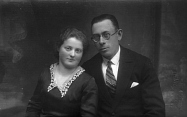 |
|
[L]: Zelda (nee Rozental) and
Lozer Kajman, Szczuczyn, 1930 |
|
| |
|
In 1931, when he was 31 years old, Eliezer married 26-year-old
Zelda (nee Rozental) and they had two sons: Norman (Nechemia) born in 1932 and
Maurice (Moshe) born in 1936. When the two boys were still very young, Eliezer
found that it was becoming impossible to make a living as a grain agent in
Poland and he was particularly hindered and bothered by anti-Jewish laws that
allowed non-Jews to renege on any debts to Jews. He had an aunt and uncle (Feiga
nee Kayman and Nachum Rosenbaum) who owned an orchard in Shepparton, Australia
so he wrote to them of his plight and later corresponded with their children.
The Rosenbaum children agreed to help their cousin Eliezer and his family
migrate to Australia by sponsoring them.
|
|
|
|
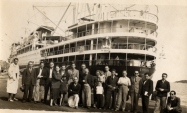
|
|
The Eridan, 1937
Docked in Sydney, Australia. They are just to the right of center;
Zelda is carrying Morrie; Lozer standing to her right; Norman standing in front. |
|
|
| |
|
Eliezer, Zelda, Norman and Maurice left Szczuczyn in June 1937. Norman was 5
years old. His brother Maurice was 16 months old. They left Poland by boat from
the port of Danzig (Gdansk), sailing first to Le Havre, France, where the family
spent a week in Paris while waiting for the next ship. From there they sailed
through the Panama Canal, to the Pacific Islands, and then on to Australia,
arriving in Sydney in August 1937 aboard the Eridan.
From Sydney, the family traveled by train to Shepparton where they lived with
Feiga and Nachum Rosenbaum for about 12 months, first working with their son
Joel in the orchard, and then helping collect scrap iron to be sold in Japan.
|
|
|
|
|
|
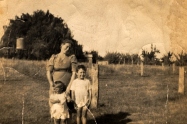 |
|
[L]: Shepparton, 1937-38, Zelda, Morrie and Norman Kayman
[R] Melbourne, 1942, with children Norman and Morrie |
|
|
|
|
|
|
In late 1938, Eliezer's family moved to Melbourne. At first they lived in
Carlton, where Norman attended the Lee Street School. After a few months, the
family moved to Glenferrie Road, Malvern, where Eliezer opened his first
Australian business: a fruit shop. There, during WWII he had to display a sign
stating that enemy aliens owned the store.
During this period, Eliezer taught himself English by reading newspapers and
copying the words in the newspaper margins. To help him remember, he would
compile long lists of English words, which he would keep on hand to refer to.
|
|
|
|
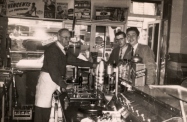
|
|
Eliezer at his second cafe on Elizabeth Street |
|
|
| |
|
In 1950, Eliezer sold his fruit shop and bought a cafe on Elizabeth St, near
Franklin Street, Melbourne. Later he sold that cafe and bought another similar
business further along Elizabeth Street, near Lonsdale Street, which he ran
until he retired in 1961.
Eliezer brought his family to Australia because life was so terribly hard in
Szczuczyn. He wanted to give his children a better future, but that never meant
that he forgot about his parents and where he had come from. Right from the time
he left Poland, Eliezer and his father wrote to each other regularly in Yiddish.
Then, in 1941, the letters stopped coming. Even before that, the letters were
telling Eliezer how the Jews' situation in Szczuczyn was deteriorating. He knew
that his father and mother were barely surviving and many of his friends were
also writing and telling of tough times. Still, it is safe to assume that when
the final letter arrived from Eliezer's only brother Nison in 1941, it was a
terrible shock.
|
|
|
|
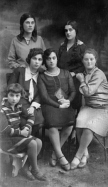 |
|
Rozental Sisters, 1928
[Back row L-R]: Yehudit, Rachel
[Front row L-R]: first 3 unidentified,
Zelda |
|
| |
|
In fact, Eliezer was so devastated when he found out what had happened to his
friends and family in Szczuczyn, he wouldn't speak about any of it at all. Our
family never really knew what had become of Eliezer's parents - we thought they
had died of starvation in the Szczuczyn ghetto. Any time anyone asked Eliezer
about Szczuczyn or the family he had left behind, he would start to cry. When he
died in 1988, we thought the stories of his life in Szczuczyn, his parents, his
brother and his friends, had died with him.
Zelda had died earlier, in 1963, and although she left us with photos of her
family and friends, the photos were largely uncaptioned, and many of the people
in them unidentifiable.
Because of this, much of our family's history was a complete mystery...until
March 2001.
On March 11, 2001 a very special photographic exhibition opened at the Museum
of Jewish Heritage in Battery Park, New York. Called "Lives Remembered: A Shtetl
Through a Photographer's Eye," the exhibition showcased many of the photographs
of Zalman Kaplan, Szczuczyn's resident photographer. On that night, many Kayman
relatives met for the first time and learnt that there is a huge extended family
spread all over the world.
Through the exhibition we found our cousin, Carolyn Kaiman Rosenstein, a
retired sociologist from Los Angeles, California, who had been tracing the
Kayman family tree. Carolyn found records of Kayman ancestors all the way back
to Chaim Kajman/Kayman, who was born around 1757 in Szczuczyn. That's 7
generations back!
There is now a Szczuczyn website:
www.szczuczyn.com, compiled by Jose Gutstein in Miami, and the
photographic exhibition will be traveling to Warsaw, New Orleans and Houston in
2004 and 2005. The now enormous interest in Szczuczyn and the Kayman family
makes these letters even more important to even more people.
As for the letters themselves, they have survived silverfish infestation a brush
with an avid stamp collector and many years in a damp garage. They were finally
rediscovered and rescued in 2003, and lovingly translated by Israel Kipen. We
thank him for his generosity and for the sensitivity with which he has unearthed
our family treasures. And we thank Melbourne's Jewish Holocaust Museum for
archiving and protecting the letters for our family, our community, and our
future generations.
Norman Kayman and Selina Kayman Joseph
June 2004 |
|
Note From the Translator: The translator of the letters, Israel Kipen,
wrote this letter to the Jewish Holocaust Museum's Head of Archives, Ursula
Flicker.
2 January, 2004
Dear Ursula
Following your suggestion during today's telephone conversation I'm jotting down
some observations about the translations and issues flowing through them.
1.. My first problem was to manage to place the letters in chronological order
which proved rather complex. Whilst some letters were clearly dated, a
substantial number of them carried the Hebrew day and month but not the Jewish
year. Some only referred to the parsha of the week as the only timepost and as
the Torah portions are repeating every year I managed to approximate the
corresponding month of the general calendar, but [was] unable to pinpoint the
year unless the text hinted on it. A considerable number of letters are not
dated and I had to divine from the text where possible, some approximation of
time. Considering that many letters are repetitive in their content, the
undating does not materially affect the story.
2.. For the discerning reader the letters convey a reasonable insight into the
state of mind of the individual writer and can serve as a reliable sample for
understanding the process of gradual decline of the socio-economic canvas of
Szczuczyn Jewry during 1937-41. Keeping in mind that it starts off from a low
point to begin with. Furthermore, this particularity can confidently be
translated into the generality of the state of Polish Jewry in the eastern part
of the country.
3.. The main character of the epic is undoubtedly Wolf Kayman, about whom some
observations are in order. To start with he is the main letter writer and bears
witness to the drama of the Kayman family, the portrait that unfolds from the
correspondence is of a typical religious Jew living in a small town between the
two World Wars. His devotion to his children and grandchildren is paramount. He
can't help himself but wear his heart on his sleeve. The departure of Lozer and
family hit him very hard and he is unable to shake himself out from the sense of
loss and his intuitive knowledge that he will never see them again, even if
outwardly he never gives up hope. The hardest part is the absence of the
grandchildren. In his emotional references to their departure he uses
expressions that repeatedly confirm his inability to make peace with this
reality even if he knows in his heart
that they are all so lucky having left. He is a tragic figure, as a human being,
as a family man and provider and the reader can't help but have empathy for the
hopelessness of his existence.
4.. An outstanding aspect of the letters is the revelation of the degree of
Jewish learning of Wolf, his son-in-law Yedidi and his younger son Nison. The
number of quotations taken from Hebrew texts is impressive, always hitting their
mark and are faultless in their spelling. One can't help but reflect, how in a
small community like Szczuczyn, and such towns could be counted in the hundreds
on the eastern rim of Poland, with such limited resources, such a standard of
Jewish learning was the norm rather than the exception. The Kayman family has
every reason to be proud of the background of their forefathers.
5.. The general introductory information regarding the family as contained in
Selina's letter to you are on the whole correct. However, one historical aspect
has to be added to the above outline. The Germans occupied Poland twice, not
once. The war started on 1-9-39 and Poland was totally occupied within 3 weeks.
However, his occupation was of only 10 days duration,
because according to the Molotov-Ribbentrop dismemberment of Poland, its eastern
part which included Bialystok, Lomza, Szczuczyn etc. belonged to the USSR and
the Germans had to vacate the territories, which they did in early October 1939.
Thus began the interlude of the Russian occupation of eastern Poland which
lasted until June 1941 when the Germans began their invasion of Russia. In other
words there was no ghetto in Szczuczyn during the period of the letters in hand.
6.. Nison's letter dated March 1941 is seminal in the sense that it confirms
that Wolf died of natural causes not from starvation as assumed.
7.. Finally, the chance of these letters ending up on my desk which I gladly
translated has an additional personal dimension. It so happens that I knew
Nochum's son Ben Rosenbaum and his wife since my arrival here. The lived in a
house in Windsor and the next house to theirs belonged to Chaim and Moshe
Dorevitch, the latter was the one to bring me out from Shanghai to Melbourne in
May 1946. I remember him well and used to meet him from time to time communally
after he retired to his house in Melbourne permanently.
Israel Kipen |